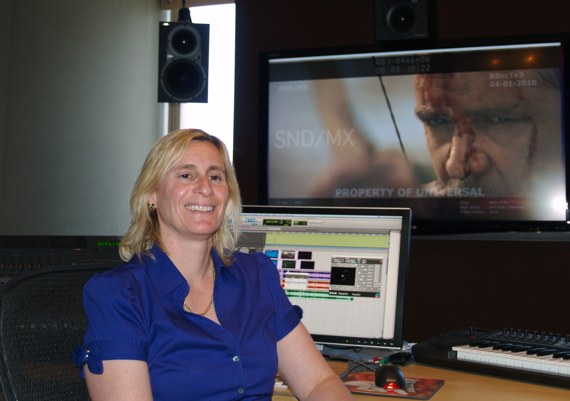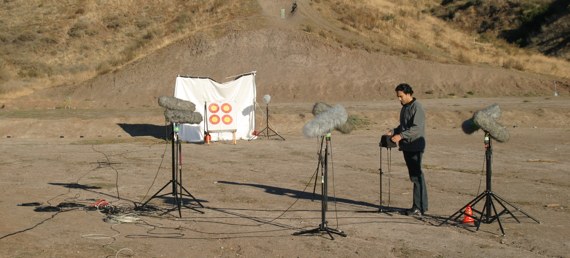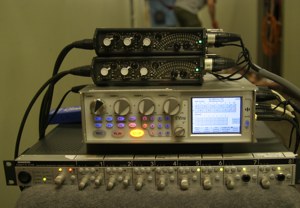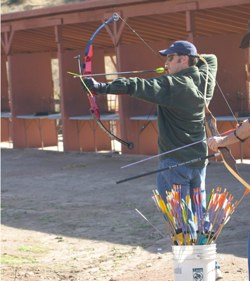
We had the opportunity to talk with the talented Ann Scibelli about her work as sound designer on Ridley Scott’s Robin Hood. Thanks to Ann for taking some time out to answer a few questions.
MIGUEL: How early did you start working on Robin Hood? What did you guys want to do different sonically than past medieval war films?
ANN: I started working on the film in its early stages, really as soon as they began assembling the first cut. As far as doing something sonically different, I think all the medieval films have the same elements really, like: horses, swords, and other weapons. I wanted this film to have a very accurate feel in terms of the backgrounds and I really wanted to concentrate my design on the bows and arrows to really create their own signature sound. I first started to develop all the background locations and the elements for the arrows. I did this even before I had any of the visual effects. I worked on the sounds for the battles, battering ram, swords, and horses. I also did some research on indigenous insects and birds in the Sherwood Forest. In the original cut of the movie there were a lot of scenes with the lost boys. The boys mostly communicated by vocalizing animal and bird calls. The boys were also sick and had coughs. We had a lot of the crew imitating vocals along with kids and used real animal vocals as well. Although, most of the scenes with the boys were cut out of the movie they still ended up playing a role in the soundtrack. One thing I also wanted to accomplish was creating a fresh sound for all the weapons and arrow whiz bys. We recorded a lot of the elements for the weapons. We actually acquired all the props that were used on the set. We had all the bows, arrows, crossbows, chain-metal, shields, clothing, and boots. Wylie Stateman had found a really cool collection of old bows and arrows on Ebay that we also had to work with. Although the props from the set looked really cool, some of them didn’t actually function well enough to produce good sound results. We also had some compound bows which we ended up using to fire the arrows. I can’t say there was an easy solution for the sound of the bows and arrows. It went through various stages. It’s interesting to hear the sound on its own when you are in the early stage of design. When you actually start to use it in context with all the elements, music, and dialogue it ends up evolving into something different.

JAKE: On a show with so much focus on bow and arrows, what kind of sounds did you experiment with as you started to work on scenes?
ANN: A combination of some of the props along with the Ebay bow and arrow collection. For the bows: I recorded different thicknesses of rope and string creating tension and snapping it against different things like wood, metal and leather. I used some recordings I had of exterior stick hits and scrapes. I recorded different sizes of mouse & rat traps snapping on wood, leather, rubber, plastic, and my finger…just kidding. I also used rawhide drums and some wood riccos. For the Crossbows: I used some of the elements recorded from the bows along with some old door latches, gun triggers, cable hits, and an old manual typewriter carriage return. There were also some elements that Foley did for the crossbow twang. For the Arrows: Charlie Campagna created a series of modified arrows using aluminum, wood, and carbon arrows. Some had different sized holes drilled into the shafts. Some were modified by attaching feathers, Brazilian whistles, duck calls, zip ties, and wire. We had Dan Kerr along with a professional archer, launching these with a compound bow in a remote exterior location. I processed them in Protools to further accentuate the interesting character of each arrow. There were also a series other things added to create the flaming arrows and some of the hero arrows. Drips from melting plastic created an interesting sizzle effect. If you don’t inhale it works the best. I used some cloth tearing elements as well.

MIGUEL: What new recordings did you utilize for the show? How much of that was done in the field versus the foley stage?
ANN: There was quite a bit of both. We recorded the arrow whooshes both inside and outside. The interior recording was nice for isolating the sound without any background ambiance but ended up being really short. The exterior versions were more useful since there was a longer distance and a wider range of microphones that could capture all the perspectives. The arrow impacts were all generated on the Foley stage. There was such a large variety of arrows hitting all type of surfaces: different size shields, dirt, mud, sand, stone, chain-metal, water, and flesh. The sword source was also generated on the Foley stage. The horse hooves were a combination of Foley and real horses. Gary Hecker did a lot of the horse breathing and it was combined with real horse vocals as well. Gary also did all of the tack & bridle. There were also some new elements for the fire. I recorded some fire by dowsing it with lighter fluid; I burnt various types of wood both dry and wet, pine needles and leaves. I used Kontakt with assignable filter sweeps, compressors and a reverb chain to create the big fireball whooshes.
MIGUEL: In a SoundWorks Collection video featuring Gary Hecker, we see some great stuff from the Foley stage. How was Foley used as a companion to your effects and design work?
ANN: There was lot of great Foley! Gary was very helpful in providing me with source for the elements. I made many requests, like arrows hitting dirt, wood, stone, and shields. Gary performed and recorded those sounds. I took those sounds, processed them and added to them. I used convolution reverb to put them in their proper space. That teamwork really contributed to the success of the soundtrack for the movie.
JAKE: The extreme close up slow-mo shots exaggerated the draw and release of a bow and arrow visually; How did you guys embellish this audibly?
ANN: It actually started with the developed sounds of the bow and arrow. Although, I used Elastic Audio to time stretch out the slow motion effect, I wanted to try to capture all the detail in a stylized way. I ended up breaking it down piece by piece featuring each element. For instance, on the string release, I created a variation starting with the original bow release and I added a pitched down water sizzle that created an interesting rippling effect. Then, I used water bubbles and water hitting wood. Last, I time stretched the sounds down, added reverb and panned that into the surrounds. I did a process like this with each element of those slow-mo scenes.
 MIGUEL: A sound idea implemented in films with gun-play is that the good guy’s gun purposely sounds different than the bad guy’s gun. Did the sound of the weapons and soldiers in “Robin Hood” differ between the hero’s and villain’s?
MIGUEL: A sound idea implemented in films with gun-play is that the good guy’s gun purposely sounds different than the bad guy’s gun. Did the sound of the weapons and soldiers in “Robin Hood” differ between the hero’s and villain’s?
ANN: They differ only slightly during the battles. Robin’s bow had a little more weight than the other bows. The hero moments were definitely bigger and more stylized. Most of the on camera shots during the castle siege were Robin and his men shooting bows and arrows. The French troops had the crossbows, which were unique to them only.
JAKE: In one of the first battles while King Richard is storming a castle there are scenes where the fighting is still going on but in the background. How did you cover these shots with such an active background?
ANN: We wanted to use native French and English Walla groups for a more authentic sound. It was also important to capture all of the different perspectives of the armies during the battle. When we are in King Richard’s tent we hear the battle cries more distant and his army more present. All of the army Walla for the French and English were recorded in England at Pinewood Studios in the back garden. We also created some distant artillery that you actually never see on camera but it certainly creates tension in the scene.
JAKE: How did you design sound for a mass of arrows like the one unleashed on the French in the final beach battle?
ANN: I used Kontakt Instruments for the incoming arrows. Some of the arrows were cut individually and panned from front to back. There was also some tonal wind and wood clattering as they were coming down. That scene was difficult in the mix. The incoming arrows were not cutting through the music score. I ended up having to create an overlay that would read through the music. I used a swarm of bees that were modulated and filtered. Then, I created spinning Doppler bys with that source. That ended up being the predominant sound in the mix.

MIGUEL: What else was challenging and fun about working on a scene as epic as the beach landing?
ANN: Any time you get to work on an epic battle scene it’s always fun. In this case, the challenge for me was to provide clarity and focus for what was on the screen without losing energy.
JAKE: How does your roll as sound designer integrate in with the rest of the sound editorial team? There has to be a bit of balancing between elements and a lot of communication between you and the rest of the sound team to insure a smooth transition to predubbing the FX. Did all of the effects work filter through you on its way to the stage?
ANN: For the final mix all the work filtered through Mark Stoeckinger, Hector Gika, and myself. Between the three of us, we handled most of the picture changes and visual effects updates. My role as a designer usually sets the tone of the film based on the pinnacle design moments; the rest of the editorial team creates effects which support those moments. In terms of communication, we had to make decisions on what effects to feature, Wylie Statemen often orchestrated these moments. The other communication challenge in this film was that Ridley Scott and Pietro Scalia liked the sound in the original temp dubs. We had to make sure that track was preserved in a way that it wouldn’t have to be recreated in the final mix. We ended up using some sections of the original temp stem where the picture hadn’t changed too drastically. The design, weapons, water, and fire were delivered as virtual pre-dubs. Although there were a lot of tracks they were all bussed out 5.1 outputs to the mixer. This gave more flexibility to allow for visual effect changes during the mix.
Thanks Ann!!!!! You ROCK!!!!
too cool!
I enjoyed reading your interview – you worded it so well that this “peasant” was able to understand. :}
You are so gifted, Ann. I am fortunate to be part of your family who is so proud of you.
It seems that the concept of virtual pre-dubs mentioned by Randy in some other posts spreads out ;-)
Awesome Interview!
Awesome interview. I am big fan of Ann’s and I have even had the pleasure of meeting her a couple times. She is an amazing sound designer as well as an awesome person.
Thanks Ann Scibelli..for sharing the knowledge..;-)..Best Regards
Although I’m not a sound designer myself, I’ve found I seem to have many similar interests both as a musician and sound recordist. I like experimenting with field recordings and finding new and interesting techniques, and also enjoy mashing together and processing sounds, which is how a lot of sound design is created, so I’ve been drawn to, and follow, sites such as the ones below.